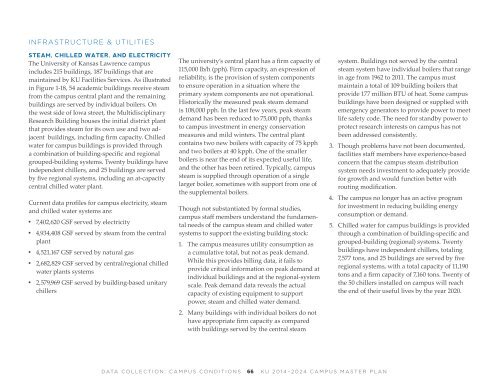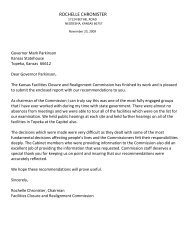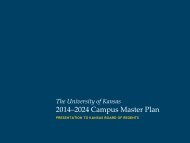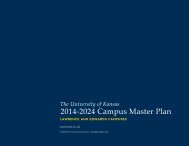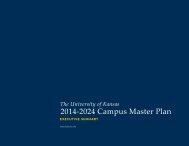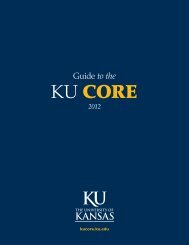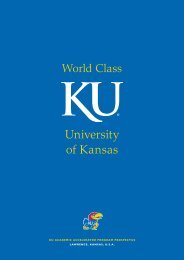KU_Chapter01_DataCollection_2014-06-10
KU_Chapter01_DataCollection_2014-06-10.pdf
KU_Chapter01_DataCollection_2014-06-10.pdf
- No tags were found...
Create successful ePaper yourself
Turn your PDF publications into a flip-book with our unique Google optimized e-Paper software.
INFRASTRUCTURE & UTILITIES<br />
STEAM, CHILLED WATER, AND ELECTRICITY<br />
The University of Kansas Lawrence campus<br />
includes 215 buildings, 187 buildings that are<br />
maintained by <strong>KU</strong> Facilities Services. As illustrated<br />
in Figure 1-18, 54 academic buildings receive steam<br />
from the campus central plant and the remaining<br />
buildings are served by individual boilers. On<br />
the west side of Iowa street, the Multidisciplinary<br />
Research Building houses the initial district plant<br />
that provides steam for its own use and two adjacent<br />
buildings, including firm capacity. Chilled<br />
water for campus buildings is provided through<br />
a combination of building-specific and regional<br />
grouped-building systems. Twenty buildings have<br />
independent chillers, and 25 buildings are served<br />
by five regional systems, including an at-capacity<br />
central chilled water plant.<br />
Current data profiles for campus electricity, steam<br />
and chilled water systems are:<br />
••<br />
7,402,620 GSF served by electricity<br />
••<br />
4,934,408 GSF served by steam from the central<br />
plant<br />
••<br />
4,521,167 GSF served by natural gas<br />
••<br />
2,682,829 GSF served by central/regional chilled<br />
water plants systems<br />
••<br />
2,579,969 GSF served by building-based unitary<br />
chillers<br />
The university’s central plant has a firm capacity of<br />
115,000 lb/h (pph). Firm capacity, an expression of<br />
reliability, is the provision of system components<br />
to ensure operation in a situation where the<br />
primary system components are not operational.<br />
Historically the measured peak steam demand<br />
is <strong>10</strong>8,000 pph. In the last few years, peak steam<br />
demand has been reduced to 75,000 pph, thanks<br />
to campus investment in energy conservation<br />
measures and mild winters. The central plant<br />
contains two new boilers with capacity of 75 kpph<br />
and two boilers at 40 kpph. One of the smaller<br />
boilers is near the end of its expected useful life,<br />
and the other has been retired. Typically, campus<br />
steam is supplied through operation of a single<br />
larger boiler, sometimes with support from one of<br />
the supplemental boilers.<br />
Though not substantiated by formal studies,<br />
campus staff members understand the fundamental<br />
needs of the campus steam and chilled water<br />
systems to support the existing building stock:<br />
1. The campus measures utility consumption as<br />
a cumulative total, but not as peak demand.<br />
While this provides billing data, it fails to<br />
provide critical information on peak demand at<br />
individual buildings and at the regional-system<br />
scale. Peak demand data reveals the actual<br />
capacity of existing equipment to support<br />
power, steam and chilled water demand.<br />
2. Many buildings with individual boilers do not<br />
have appropriate firm capacity as compared<br />
with buildings served by the central steam<br />
system. Buildings not served by the central<br />
steam system have individual boilers that range<br />
in age from 1962 to 2011. The campus must<br />
maintain a total of <strong>10</strong>9 building boilers that<br />
provide 177 million BTU of heat. Some campus<br />
buildings have been designed or supplied with<br />
emergency generators to provide power to meet<br />
life safety code. The need for standby power to<br />
protect research interests on campus has not<br />
been addressed consistently.<br />
3. Though problems have not been documented,<br />
facilities staff members have experience-based<br />
concern that the campus steam distribution<br />
system needs investment to adequately provide<br />
for growth and would function better with<br />
routing modification.<br />
4. The campus no longer has an active program<br />
for investment in reducing building energy<br />
consumption or demand.<br />
5. Chilled water for campus buildings is provided<br />
through a combination of building-specific and<br />
grouped-building (regional) systems. Twenty<br />
buildings have independent chillers, totaling<br />
7,577 tons, and 25 buildings are served by five<br />
regional systems, with a total capacity of 11,190<br />
tons and a firm capacity of 7,160 tons. Twenty of<br />
the 50 chillers installed on campus will reach<br />
the end of their useful lives by the year 2020.<br />
DATA COLLECTION: CAMPUS CONDITIONS<br />
66<br />
<strong>KU</strong> <strong>2014</strong>–2024 CAMPUS MASTER PLAN


